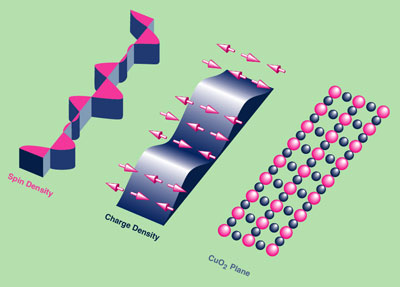| Posted: December 1, 2008 |
'Striped' material offers more clues to high-temperature superconductivity |
|
(Nanowerk News) Scientists studying a material that appeared to lose its ability to carry current with no resistance say new measurements reveal that the material is indeed a superconductor — but only in two dimensions. Equally surprising, this new form of 2-D superconductivity emerges at a higher temperature than ordinary 3-D superconductivity in other compositions of the same material. The research, conducted in part at the U.S. Department of Energy’s (DOE) Brookhaven National Laboratory, will appear in the November 2008 issue of Physical Review B, and is now available online.
|
|
“Our basic research goal is to understand why and how these materials act as superconductors,” said Brookhaven physicist John Tranquada, who led the research. “The ultimate practical goal would be to use that understanding to develop improved bulk superconductors — ones that operate at temperatures warm enough to make them useful for real-world applications such as high-efficiency power lines.”
|
|
The basic idea behind superconductivity is that electrons, which ordinarily repel one another because they have like charges, pair up to carry electrical current with no resistance. Conventional metallic superconductors do this at temperatures near absolute zero (0 kelvin or -273 degrees Celsius), requiring costly cooling systems. More recently, scientists have discovered materials that transition to superconductivity at higher temperatures, sparking the hope for future room-temperature devices.
|
 |
| Stripe order in the copper oxide planes involves both a modulation of the charge density (blue), detectable with x-ray diffraction, and a modulation of the arrangement of magnetic dipole moments (spin directions) on copper atoms (magenta arrows), detectable with neutron diffraction.
|
|
Tranquada and his colleagues have been studying a layered material made of lanthanum, barium, copper, and oxygen (LBCO) where the ratio of barium to copper atoms is exactly 1 to 8. At a range of compositions with lower and higher levels of barium, LBCO acts as a “high-temperature” superconductor, with a peak operating temperature of 32 K. But at the mysterious 1:8 ratio, the transition temperature at which superconductivity sets in drops way down toward absolute zero.
|
|
This material exhibits another interesting property: an unusual pattern of charge and magnetism known as “stripes,” which many theorists have long assumed was incompatible with superconductivity.
|
|
“For a superconductor, you need charges to be paired and moving coherently to carry a current with no resistance. On the other hand, the ‘stripe’ order suggests the charges are localized in relatively fixed positions,” Tranquada explained. So the presence of alternating stripes of magnetism and charge — which are most apparent in the composition with the 1:8 ratio of barium to copper — seems perfectly consistent with the fact that LBCO’s superconductivity “disappears” at exactly that point.
|
|
But earlier Brookhaven studies suggest that the stripes do exist in other, superconducting copper oxides, in a way that is more fluid and therefore harder to detect. Now, the latest measurements suggest that a similarly hard-to-detect form of superconductivity occurs in the LBCO 1:8 composition.
|
|
One of the key measurements, made by Brookhaven physicist Qiang Li, was of electrical resistance parallel to the planes of the layered material and also perpendicular to them. At a particular temperature, Li detected a big drop in resistance when the current was flowing parallel to the layers, but not when it was flowing perpendicular to them.
|
|
At the same time, Brookhaven physicist Markus Hücker, along with Qiang Li, measured the onset of weak “diamagnetism,” an effect in which magnetic fields are pushed out of the sample. “This is one of the key properties of a superconductor — the Meissner effect,” Tranquada said.
|
|
Like the drop in resistance, the Meissner effect occurred in only two dimensions, within the planes.
|
|
“Combining these results with a variety of other measurements, we now propose that there is a subtle form of superconductivity confined within the two-dimensional planes of copper oxide in LBCO 1:8,” Tranquada said.
|
|
“For some reason,” he continued, “the material is unable to coherently couple that superconductivity between the planes. It’s as if you were in a skyscraper where the elevators don’t work and there aren’t any stairs. You can move within the same floor but you can’t get from one floor to the next. That’s the case for the electron pairs in this material; they can’t move from one layer to the next.”
|
|
The scientists are particularly intrigued by this new form of 2-D superconductivity because it sets in at an even higher temperature (40 K) than that at which 3-D superconductivity occurs in other forms of LBCO.
|
|
“The ultimate practical goal is to find or create superconductors that can operate at room temperature, thus eliminating the need for costly cooling systems. So research aimed at understanding the features that enhance superconductivity is an important step toward designing superconductors that work at higher temperatures,” Tranquada said.
|

